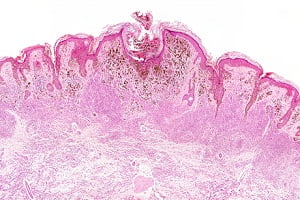Treatment of Melanoma Skin Cancer
- Updated on: Jul 29, 2024
- 2 min Read
- Published on Feb 21, 2021

Treating Early-Stage Melanomas
Early-stage melanomas are generally treated through surgery to remove the melanoma through surgical excision. A very small (thin) melanoma may be removed completely during a biopsy and may not require any further treatment. Your surgeon may also want to remove the cancer as well as a border of normal skin and a layer of tissue beneath the skin to avoid the cancer coming back.
This procedure is preferred for melanomas that have not grown deeper than the top layer of the skin (the epidermis). Your doctor may send the removed sample to a lab to investigate if the cancer cells are seen at the edges of the sample through a microscope. In such a case, an excision of the area may be done again.
Sometimes, a doctor may use radiation therapy instead of or along with the surgery. But most doctors do not follow this approach and do not even agree with this treatment for initial stage melanomas.
Treating Melanomas That Have Spread Beyond the Skin
If melanoma has spread beyond the skin (epidermis), treatment options may include:
Surgery
Surgery is done to remove affected lymph nodes if the cancer has spread beyond the epidermis to such as the surrounding lymph nodes. He may perform additional treatments as needed along with the surgery such as radiation therapy.
Radiation Therapy
Radiation therapy involves high-powered energy beams, such as X-rays, to destroy cancer cells. Radiation therapy may be recommended after surgery to remove the lymph nodes and also avoid the cancer coming back after it has been treated. Sometimes, it helps relieve symptoms of melanoma that has spread to other areas of the body.
Targeted Therapy
Targeted therapy is used to inject medications that are aimed to target specific vulnerabilities in cancer cells. There may be certain side effects of targeted therapies such as skin problems, chills, fever, and dehydration.
Vemurafenib (Zelboraf), dabrafenib (Tafinlar) and trametinib (Mekinist) are examples of some drugs that are used in the targeted therapy to treat advanced stage melanoma.
Chemotherapy
Chemotherapy also involves the use of certain drugs to destroy cancer cells. Chemotherapy can be given intravenously, in the form of pills or both as recommended by the doctor. The aim is to destroy the cancer cells throughout your body. Chemotherapy has shown only limited success in the treatment of melanoma. Dacarbazine is FDA-approved drug for Stage IV (metastatic) melanoma that is delivered as chemotherapy.
Immunotherapy
Immunotherapy is a type of systemic therapy that is used in the treatment of melanoma at high risk for recurrence and metastases. Following immunotherapies are approved by the FDA for the treatment of melanoma:
- Yervoy + Opdivo,
- Keytruda (pembrolizumab),
- Yervoy (ipilimumab),
- Interleukin-2 (IL-2) and Interferon alpha 2-b
- Opdivo (nivolumab), and
- Imlygic (T-VEC)
Biological Therapy
Biological therapy improves your immune system and helps your body fight cancer. Biological therapies may involve substances that are produced by the body or other similar substances manufactured in a laboratory. There can be side effects such as chills, fatigue, weakness, fever, headache and body aches.
Few examples of substances used in biological therapies to treat melanoma are interferon, interleukin-2, ipilimumab (Yervoy), nivolumab (Opdivo), and pembrolizumab (Keytruda).
If your melanoma can’t be cured (such as when it is at an advanced stage), your doctors will try to manage symptoms and reduce complications so as to keep you feel comfortable. Your doctor may also recommend that you join a clinical trial . Clinical trials often offer better treatment options for people who have metastatic cancer. Clinical trials study other treatments, such as combinations of therapies, vaccines, and immunotherapies, targeted therapy etc.












